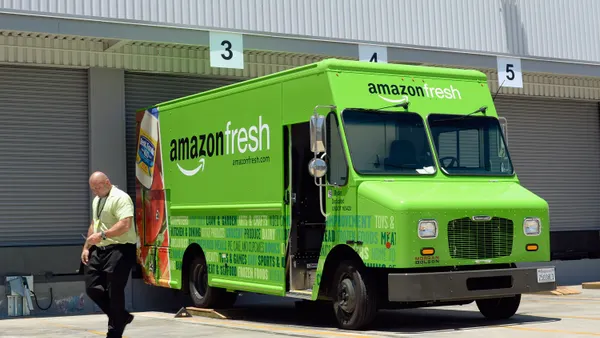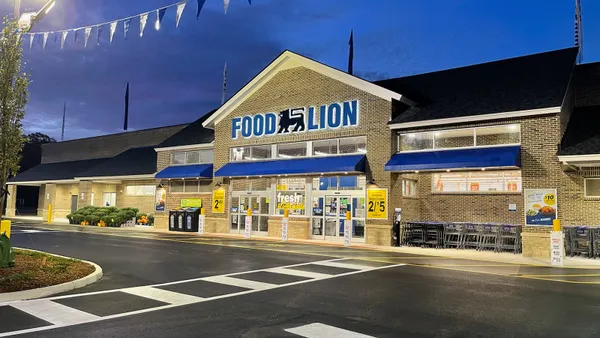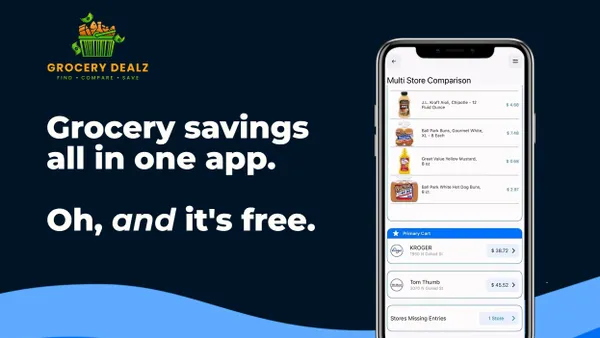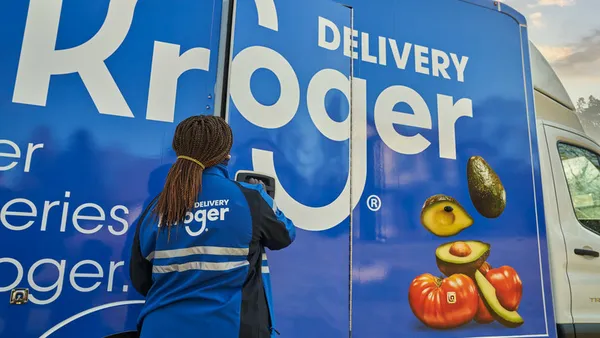UPDATE: May 26, 2020: The number of states that have received federal approval to allow SNAP participants to purchase food online has grown to 36, the U.S. Department of Agriculture announced May 20, accounting for 90% of all SNAP recipients. There are currently 18 states where the program is operational, and the rest will phase in over the coming weeks, the USDA said. The government has also expanded the number of food retailers able to accept SNAP benefits through their e-commerce platforms.
Dive Brief:
- The U.S. Department of Agriculture on Tuesday approved three additional states — Kentucky, Missouri and Texas — to provide online food purchasing to customers enrolled in the Supplemental Nutrition Assistance Program (SNAP), according to a press release. That brings the total number of states approved under the pilot program that began last year to 16 — 14 of which have been added since the beginning of March.
- Amazon announced Tuesday it is approved to begin selling groceries to SNAP consumers in Florida, while Hy-Vee told Grocery Dive it is working on enabling SNAP payments for click-and-collect orders. Walmart is also working on expanding online SNAP buying options, Tom Ward, the company's senior vice president of customer product, wrote in a recent post, while Kroger recently announced it would begin letting SNAP shoppers use their EBT cards to pay for pickup orders at more than 2,000 stores.
- More than 20 million Americans have filed for unemployment over the past month, and states are seeing a surge in SNAP applications. Business Insider Intelligence estimates that 49% of all U.S. consumers will have tried grocery e-commerce by the end of this year.
Dive Insight:
Many retailers have extended special online services to the elderly and disabled, and many SNAP recipients fall into this vulnerable population looking for low- or no-contact payment options during the pandemic. A 2015 survey of SNAP recipients found that 4.4 million households, representing around 20% of total households in the program, have senior citizens in them, while 4.5 million contain non-elderly disabled individuals.
Meanwhile, Americans are applying for SNAP assistance at record rates right now. Alabama’s online applications for the program increased 155% between February and March, while California’s applications more than doubled between the beginning and end of March. Iowa’s SNAP applications over the past four weeks are up more than 80% over the same time frame last year, according to the Des Moines Register.
The USDA’s e-commerce SNAP pilot, which launched last year, was expanding slowly, with the agency announcing in January that Washington had joined New York as the second state to enable online purchasing for recipients. Then the pandemic put a charge into it. In March, Iowa, Alabama and Oregon were added to the list of approved states. In April, a wave of additional states, including California, Arizona, North Carolina, Vermont and West Virginia, received approval. The USDA has approved a host of additional states, including Connecticut, Illinois, Ohio, Pennsylvania and Tennessee, since the beginning of May, the agency announced May 20.
But approval doesn’t mean retailers can immediately turn on access. The main hurdle to implementation is the fact that SNAP users must input a PIN number corresponding to their account when they check out. States and retailers must enable a payment program that incorporates and can securely process shoppers’ PIN numbers. Additionally, retailers must update their online ordering systems to factor out sales tax for SNAP purchases, handle manufacturer coupons and enable refunds for recipients, and implement a separate payment tender option for delivery fees, which SNAP dollars do not cover.
States also must update their Electronic Benefits Transfer (EBT) systems to be able to process, track and store online SNAP data.
The USDA said it will expand the number of grocers able to accept SNAP benefits online when it announced the latest round of states added to the program. Initially, the only retailers able to process these transactions were those approved when the pilot launched last year, which included Amazon and Walmart. ShopRite stores in New York state and Wright's Supermarkets locations in Alabama were also part of that group.
Online payments under the USDA’s pilot program provide a contactless way for shoppers to buy groceries. But becoming fully compliant is also complex and time-consuming, so retailers have rolled out pickup programs that allow SNAP consumers to shop online and then pay once they retrieve their order.
Walmart offers this at all of its pickup-enabled stores, and Kroger was set to have the same measure in place by the end of April. Hy-Vee spokeswoman Christina Gayman told Grocery Dive in April that the chain was considering a similar option, but did not provide a timeline.
Ohio recently rolled out a click-and-collect program in partnership with the USDA to make e-commerce for widely available for SNAP users in the state. State legislators are pushing for more states to receive approval for online shopping and for retailers like Amazon and Walmart to waive delivery fees for SNAP consumers during the pandemic.
For now, the majority of consumers receiving food assistance must continue shopping for groceries in stores, where retailers have implemented numerous safeguards, from one-way aisles to plexiglass barriers at checkout.











